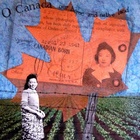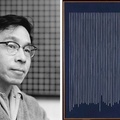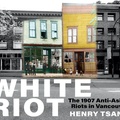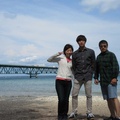
Akira Yoshikawa, Artist, Toronto
My first encounter with Kazuo Nakamura’s artwork was at the Art Gallery of Ontario. I was still a teenager trying to decide what direction to take after my graduation from high school. I knew I had strong interests in design and architecture.
As I was roaming around the gallery, one painting in particular caught my attention. The painting depicted stacked architectural blocks in a minimal modernist landscape. The artist had only used black, blue, and white paints. There are no human figures in the painting, the atmosphere is desolate and cold. I looked at the label and discovered that it was by Kazuo Nakamura, the work was called Fortress painted in 1956.
I did not know the artist. But I felt a connection and a sense of comfort because of our Japanese names. But never did I imagine that I would be exhibiting my artwork along with Kazuo Nakamura later on in my life. Our works were included in the 1987 group exhibition Shikata Ga Nai, a survey of contemporary art by Japanese Canadians co-ordinated by Bryce Kanbara. The positive karma was in alignment with us.

The last time I saw Kazuo was in 2001 at the Robert McLaughlin Gallery in Oshawa for the opening of his retrospective exhibition The Method of Nature. But I was informed that he was quite ill because of Lou Gehrig disease (ALS).
During the opening I was mesmerized when I came upon his painting called Into Space painted in 1954. I stood in front of the work for a long time, trying to figure out what it was all about. There aren’t too many elements in the composition one can relate to; three vertical lines created by strings, the overall colour of blue brush strokes are mostly vertical but unevenly applied. The overall feel in the 22” x 27” canvas is barren, sparse. Thinking about it now, it is very similar to the experience one gets when sitting in front of a Zen garden such as at the Daisen-In in Kyoto. The subject matter, therefore, is Universal.
A few days after the opening I wrote him a letter expressing how much I was intrigued and challenged by the painting, Into Space.
Understandably I never heard back from him.
* * * * *
Bryce Kanbara, Artist/Curator, Hamilton, ON
Kaz Nakamura was one of very few Nisei Japanese Canadians who chose to be artists -- a questionable choice of careers in any case and at any time—but particularly so in a community that had just lost everything during the WW2 internment of Japanese Canadians (JCs) and was struggling with the challenges of rebuilding their lives and dealing with the psychic effects of the government’s harsh treatment of them. Somehow Kaz focused on making art and being recognized as an artist as good as any, and better than most.
Those of us in the succeeding generation who were drawn to Art saw in Kaz, and other Nisei in the arts such as Roy Kiyooka (1926-1994), Takao Tanabe, Raymond Moriyama, Joy Kogawa (who as I mentioned, were very few in number) as incredible and formidable examples of going against the grain, making important art that was recognized nationally and internationally. And while his art life was quite removed from the JC community, he remained in touch and at one time, deeply involved in the JC community.
Enlightened JCs engaged his participation in creating the vision for the Japanese Canadian Cultural Centre building on Wynford Drive, for example, which by the way was Raymond Moriyama's (1929-2023) first major project. Kaz had files of material stored away—the accumulation of a decade of work to establish the JCCC.
I sensed in his quiet demeanour and persevering attitude a quality that perhaps reflects the intergenerational trauma that is talked about so much nowadays. A consequence of the Internment, of the post-war urge to assimilate, to not be punished for being of Japanese descent. The model minority syndrome.
In spite of this, Kaz both contributed to his community (JCCC) and made great art, which most in the community were aware of because of the acclaim accorded to him in the art world.
The pressure to achieve upward social mobility and assimilation was really powerful. I know several artists of my generation who got their degrees in Fine Art and then came to their senses and became lawyers and economists.
He was reserved and unassuming in public, particularly in comparison to other members of Painters Eleven who were not only extroverted but also charismatic. Harold Town, William Ronald just as his work was also always perceived as quieter, more calculated and thought-based, rather than emotion-based.
Although his demeanour may have made him appear socially reticent, he was supremely confident in the importance of his work. And he built that self-confidence, as he constructed his ideas about painting – systematically. He knew his mathematical work reflected advanced and difficult ideas, particularly when presented in an Art context, as paintings, in exhibitions at art galleries. People liked them but they were puzzled over them.
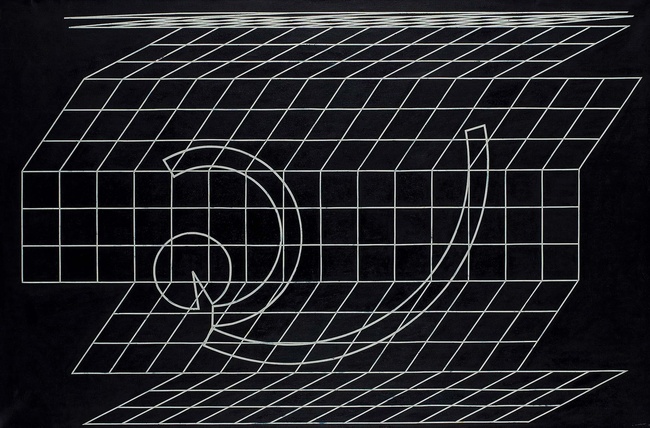
His number structure paintings (I asked him why he felt it necessary to make them, when the real excitement of his explorations seemed to lie in the stacks of pencilled formulations he made over the years. The aesthetic expression of what he was thinking – the connection of his ideas to nature and to painting – was still very meaningful to him. And thankfully for us, because they’re beautiful. I've thought that they reminded me of the movie “A Beautiful Mind.”
There are some scenes where the cascading formulas and numbers seem unintelligible, but they transport us.
But he was Canadian and an internationalist in this way of thinking. (1988 Shikata ga nai statement.) I asked all the artists “What does being Japanese Canadian mean to you?” Kaz’s answer was unambivalent.
“For Canadian painters of Japanese parentage, it means some awareness of eastern cultural flow, in particular the development of nature concept and sophistication of natural design. Those may have some impact on our thinking.”
* * * * *
Christopher Cutts, Christopher Cutts Gallery, Toronto
In 1987, the AGO held a reception for every artist who was part of their permanent collection. I attended the reception with artist John MacGregor, who, upon seeing Kazuo Nakamura at the event, offered to introduce me to him. So, he took me over to Nakamura, and I asked what he was presently working on, to which he responded, Number Structure.
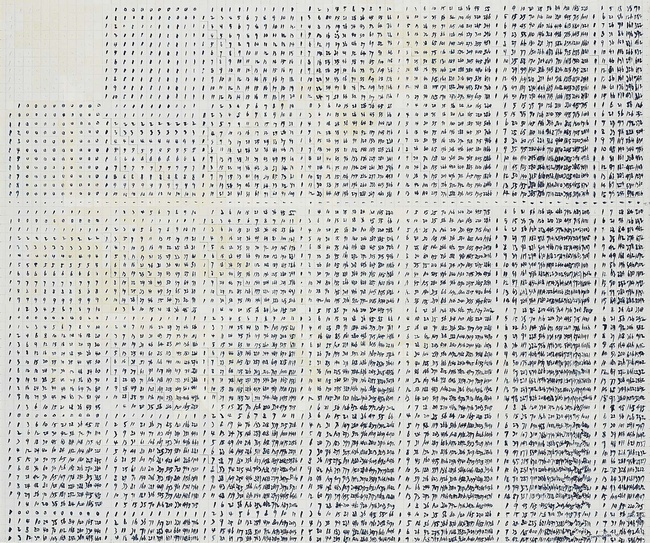
Not painting, but the study of numerical sequences and patterns, creating forms and dimensions that mirror the natural world. After hearing his answer, I asked if I could visit his studio, and he said yes.
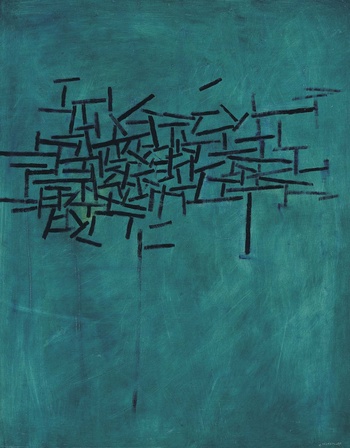
I would go there regularly, developing a keen appreciation for Kazuo’s work as he patiently explained his concepts to me each visit. At the time, he was completely dedicated to Number Structure. He was committed to his research and confident that what he was doing was important. While his investigations on the subject began in the 1970s, his interest in the internal complexities of the universe is evident in early abstractions dating back to the fifties, often titled Inner View or Inner Structure.
Artist Dennis Burton once recalled to me a chance encounter between the two in the sixties. He noticed Kazuo carrying a rolled-up copy of Scientific American. When he questioned this choice of publication as opposed to, say, an art journal, Nakamura simply responded, “I want to know the truth.”
That was what distinguished Nakamura’s aesthetic from his contemporaries, he was a man of intellectual fervour, obsessively curious.

* * * * *
Kathy Okawara, A Friend, Toronto
My Friendship With Kaz
My late husband, architect Harvey Okawara (1926-2010), was a close friend of Kaz Nakamura. He met Kaz in Tashme when they were about 16 and their friendship developed with their shared interest in art. Unlike Harvey, Kaz was serious and instead of joining the teenage social groups in Tashme, Kaz was focusing on his art and work. It quite surprised Harvey to realize just how many paintings Kaz produced in Tashme when they were featured in the 2001 Exhibit at the Japanese Canadian Cultural Centre gallery.
Their friendship continued after evacuation when they both lived In Toronto despite their different career paths. They became involved in the planning project of the Japanese Canadian Cultural Centre and after these planning meetings they spent hours in conversation late into the night when Harvey would drive Kaz home. When Kaz told him he was getting married, Harvey offered to drop by City Hall to take photos. When he arrived, Lillian said, “Good, we can start now that the best man has arrived!”
Belying the media descriptive of Kaz as a recluse, his friends often enjoyed social gatherings which Kaz would host in his home and allow us to preview his latest works. As his art evolved and he became obsessed with his number series, we were challenged with his explanation which he presented with the reams of charts and graphs he meticulously created before he concluded with the final artwork. After his marriage to Lillian, the friendship continued although the focus centred more around our growing families.
Despite his brilliance and accolades of fame in the art world, Kaz remained a kind, generous, and humble man. He often joked that he only wore grey shirts which he bought at the Army & Navy Store and when they went out of business, his wife Lillian would sew him similar grey shirts.
Always analytical by nature, Kaz answered questions backed up with the reference material he has squirrelled away. Even when we decided to invest in the stock market for fun, Kaz produced rolls of detailed handwritten charts and graphs of each potential company; but we didn’t make any money!
—An artist, scholar, and a true friend
© 2024 Norm Masaji Ibuki


